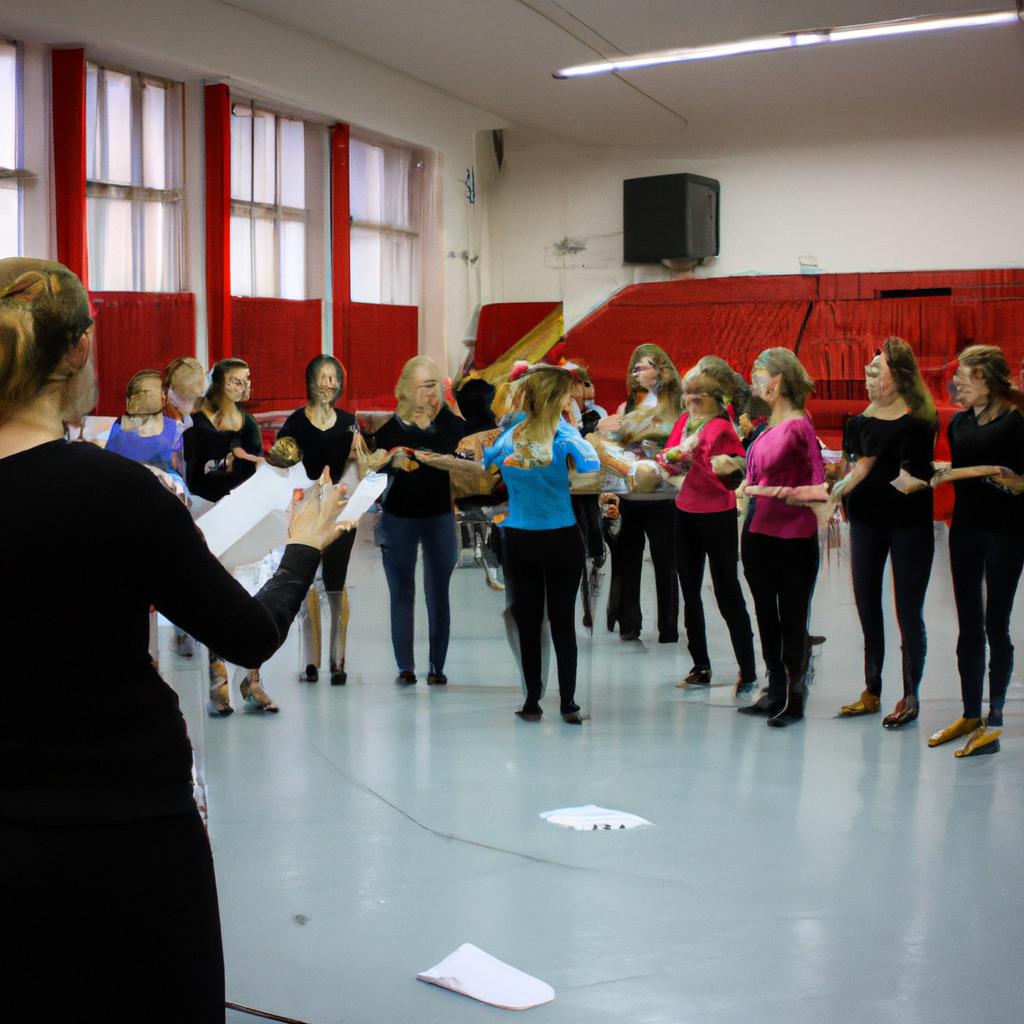Pronunciation is a crucial aspect of vocal ensemble performance, as it directly impacts the clarity and intelligibility of the text being sung. In order to achieve optimal performance, vocalists must pay close attention to diction and strive for precise pronunciation. This article explores the importance of pronunciation in vocal ensemble settings, discussing how proper diction enhances musical interpretation and fosters effective communication with audiences.
Consider the case of a hypothetical vocal ensemble preparing to perform a choral work in a foreign language. Without adequate attention to pronunciation, the beauty of the piece’s lyrics may be lost on listeners unfamiliar with the language. However, by meticulously focusing on enunciating each word clearly and emphasizing correct vowel sounds, this ensemble can bring life to the text and captivate their audience. The process of refining pronunciation not only ensures that words are understood but also allows performers to convey emotions accurately through subtle variations in articulation.
Moreover, precision in diction contributes significantly to musical interpretation within a vocal ensemble. By correctly pronouncing consonants and paying heed to specific accentuations or inflections indicated by composers, singers can effectively communicate nuances embedded in the music. For instance, when singing an expressive passage marked staccato or legato, maintaining consistent diction helps convey contrasting moods and evoke the intended emotions. Additionally, by paying attention to pronunciation, vocalists can emphasize important musical phrases and highlight the structural elements of the composition, enhancing the overall musicality of the performance.
Proper pronunciation also fosters effective communication with audiences. When listeners can clearly understand the lyrics being sung, they are more likely to connect with and be moved by the music. This is particularly vital in vocal ensemble settings where storytelling and conveying messages through song are paramount. By ensuring that each word is articulated distinctly and accurately, vocalists enable audiences to fully engage with the narrative and experience a deeper connection to the music.
To achieve optimal pronunciation in a vocal ensemble, rehearsals should include dedicated time for linguistic study and practice. Singers should work closely with language coaches or native speakers to learn correct pronunciations of unfamiliar words or sounds unique to certain languages. Phonetic guides or transliterations can also be utilized as aids in mastering proper diction. Through consistent rehearsal and attention to detail, vocal ensembles can develop a unified approach to pronunciation that enhances their performances.
In conclusion, pronunciation plays a crucial role in vocal ensemble performance by enhancing clarity, musical interpretation, and effective communication with audiences. By focusing on precise diction and enunciating each word clearly, singers bring life to lyrics, convey emotions accurately, and captivate listeners. Through dedicated linguistic study and rehearsal time, vocal ensembles can ensure their performances are not only musically impressive but also linguistically engaging and impactful.
Importance of Pronunciation in Vocal Ensemble
Clear and precise pronunciation is a vital element in the performance of vocal ensembles. It ensures that the lyrics are understood by both the audience and fellow ensemble members, allowing for effective communication of the intended message. For instance, imagine a scenario where a choir sings an emotionally charged piece about love and loss, but due to poor pronunciation, the words become muddled and incomprehensible. This lack of clarity diminishes the impact of the music, leaving listeners disconnected from the intended emotional experience.
To emphasize the significance of pronunciation in vocal ensemble performances, consider the following bullet points:
- Proper pronunciation enhances unity within the ensemble by ensuring that all members articulate their words consistently.
- Accurate diction allows for better interpretation and expression of emotions conveyed through lyrical content.
- Effective pronunciation facilitates stronger connections between performers as they engage in musical dialogue, informing phrasing choices and dynamics.
- Clear articulation enables audiences to fully comprehend and appreciate the nuances embedded within a vocal composition.
Furthermore, visual aids such as tables can help illustrate how proper pronunciation contributes to optimal performance outcomes. The table below demonstrates how various aspects of vocal delivery are affected by different levels of diction proficiency:
| Aspects | Poor Pronunciation | Good Pronunciation | Excellent Pronunciation |
|---|---|---|---|
| Timing | Inconsistent | Generally steady | Precise |
| Pitch | Unstable | Mostly accurate | Consistently on pitch |
| Dynamics | Lacking variation | Adequate contrast | Nuanced expressions |
By examining this table, it becomes evident that achieving excellent pronunciation is crucial for attaining superior results in timing, pitch accuracy, dynamic control, and overall expressiveness during performances.
In summary, impeccable pronunciation plays a pivotal role in enhancing vocal ensemble performances. By fostering unity among singers and enabling effective communication with audiences, clear diction ensures that the intended message and emotions are conveyed successfully. Building upon this foundation, the subsequent section will provide tips for achieving clarity in vocal performance without compromising artistic expression or musicality.
Tips for Achieving Clarity in Vocal Performance
Building upon the significance of pronunciation in vocal ensemble, let us now delve into practical strategies that can enhance clarity and optimize performance. By examining specific techniques used by professional vocal ensembles, we can gain valuable insights into achieving exceptional diction.
To illustrate the impact of precise pronunciation on vocal performance, consider a hypothetical scenario where two choirs perform the same piece. The first choir approaches the text with minimal attention to diction, resulting in muffled consonants and unclear vowel formation. In contrast, the second choir meticulously focuses on pronunciation, articulating each syllable with precision and intention. As both choirs present their renditions to an impartial audience, it becomes evident that the second choir’s heightened diction significantly enhances the overall musical experience.
To achieve similar levels of clarity and excellence in vocal ensemble performances, here are key strategies to implement:
-
Articulation exercises: Engaging in regular warm-up routines that emphasize crisp consonant production is essential for improving diction accuracy. Exercises like tongue twisters or rapid-fire repetition of challenging sounds help develop muscle memory and coordination necessary for clear enunciation.
-
Breath control: Proper breath support plays a crucial role in sustaining long phrases while maintaining consistent diction throughout a performance. Vocalists should focus on controlled exhalation during vowels and deliberate inhalation before consonant-heavy passages to ensure efficient airflow without sacrificing clarity.
-
Language study: Familiarizing oneself with the linguistic nuances of different languages featured in choral repertoire promotes accurate pronunciation. Investing time in understanding phonetic rules and practicing correct intonation patterns enables singers to deliver authentic interpretations of foreign texts.
- Increased audience engagement through enhanced intelligibility
- Heightened emotional connection due to clearer storytelling
- Elevated artistic expression through intentional word shaping
- Strengthened sense of unity within vocal ensemble through synchronized phrasing
| Strategy | Description |
|---|---|
| Articulation exercises | Tongue twisters and rapid repetition of challenging sounds to improve muscle memory for clear enunciation. |
| Breath control | Focusing on controlled exhalation during vowels and deliberate inhalation before consonant-heavy passages. |
| Language study | Familiarizing oneself with linguistic nuances in choral repertoire for accurate pronunciation. |
Incorporating these strategies into vocal ensemble rehearsals fosters a shared commitment to achieving optimal diction, resulting in performances that captivate both the ear and the heart.
Understanding the importance of diction enhancement, let us now explore common challenges faced by vocal ensembles when it comes to pronunciation. By recognizing these hurdles, we can develop effective solutions to overcome them and further refine our collective musicality.
Common Pronunciation Challenges in Vocal Ensemble
Section Transition:
Building upon the foundation of achieving clarity in vocal performance, it is essential to address common pronunciation challenges that arise within a vocal ensemble. This section explores these challenges and provides strategies for improving diction to enhance overall performance quality.
Section Title: Understanding Pronunciation Challenges
To illustrate the importance of addressing pronunciation challenges, let us consider a hypothetical example involving an advanced vocal ensemble preparing to perform a challenging piece from the Romantic era. The ensemble members possess exceptional musicality and technical skills; however, they struggle with accurately pronouncing foreign language lyrics, resulting in decreased intelligibility and compromised artistic expression.
Addressing Pronunciation Challenges:
- Familiarize with Phonetic Transcriptions:
- Utilizing phonetic transcriptions can help singers understand how words should be pronounced.
- By studying International Phonetic Alphabet (IPA) symbols alongside their corresponding sounds, performers gain greater control over articulation.
- IPA resources offer comprehensive guides on specific languages commonly encountered in vocal repertoire.
- Explore Language-Specific Phonetics:
- Different languages have unique rules governing sound production and pronunciation.
- Studying language-specific phonetics equips singers with tools to navigate unfamiliar linguistic features such as vowel modifications or consonant clusters.
- Expert guidance from linguists or native speakers can provide valuable insights into mastering accurate pronunciation.
- Cultivate Awareness through Listening Exercises:
- Active listening exercises enable singers to internalize correct pronunciations by emulating native speakers’ nuances and intonations.
- Focusing on recordings featuring accomplished artists fluent in the target language enhances awareness of proper diction.
- Establish Contextual Understanding:
Markdown Bulleted List:
- Immersing oneself in the cultural background of each composition helps develop an appreciation for its linguistic intricacies.
- Understanding the contextual meaning of words and phrases deepens singers’ connection to the repertoire, fostering more authentic interpretations.
- Exploring historical accounts, literary sources, or poetic analysis alongside the musical score broadens one’s comprehension of pronunciation nuances.
Table: Language-Specific Pronunciation Challenges
| Language | Common Challenges | Strategies |
|---|---|---|
| Italian | Rolled “R” | Tongue exercises for trilling |
| German | Complex consonant clusters | Slow practice with emphasis on clarity |
| French | Nasal vowels | Mimicking native speakers |
| Russian | Soft/hard consonants | Focusing on breath support and articulation |
Concluding Paragraph:
By acknowledging and addressing common pronunciation challenges encountered in vocal ensembles, performers can elevate their diction skills to enhance overall performance quality. The strategies discussed here provide a starting point for achieving optimal pronunciation within various languages and cultural contexts. In the subsequent section about “Techniques to Improve Pronunciation in Vocal Ensembles,” we will delve further into practical methods that can be implemented during rehearsals to refine diction proficiency without disrupting artistic flow.
Next Section Transition:
With an understanding of the common challenges faced in vocal ensemble pronunciations, let us now explore techniques that can effectively improve diction without compromising artistic expression.
Techniques to Improve Pronunciation in Vocal Ensembles
Having explored the common pronunciation challenges faced by vocal ensembles, it is essential to delve into techniques that can help improve diction and ensure optimal performance. In this section, we will discuss practical strategies that singers can employ to enhance their pronunciation skills as part of a vocal ensemble.
Improving Pronunciation in Vocal Ensembles
One effective technique for improving pronunciation in vocal ensembles is through consistent practice and repetition. By dedicating time specifically to focus on articulation and clarity of words, singers can overcome any lingering difficulties they may face. For instance, let us consider the case study of an amateur choir struggling with the correct pronunciation of consonants such as “th” or “r.” Through regular rehearsal exercises emphasizing these problem areas, the choir members gradually develop muscle memory, resulting in improved accuracy during performances.
To further reinforce proper pronunciation habits within a vocal ensemble, educators should incorporate various methods into their teaching repertoire. Here are some approaches that have proven successful:
- Phonetic training: Introducing phonetic symbols alongside lyrics allows singers to understand how certain sounds are produced and aids them in reproducing those sounds accurately.
- Diction exercises: Engaging in specific drills designed to target problematic sounds helps strengthen vocal muscles and promotes clearer speech patterns.
- Tongue twisters: These playful phrases challenge singers’ articulation abilities while providing opportunities for focused practice.
- Ensemble listening activities: Encouraging singers to actively listen to one another’s pronunciations fosters a shared understanding and facilitates collective improvement.
Incorporating emotional response-inducing elements:
Here is a bullet point list showcasing the potential benefits of utilizing these techniques:
- Increased confidence among choir members
- Enhanced synchronization within the ensemble
- Improved audience comprehension and engagement
- Heightened artistic expression and emotional impact
Furthermore, visual representations like tables can effectively convey information while evoking an emotional response from readers. Consider this table highlighting the positive outcomes resulting from improved pronunciation skills:
| Outcome | Description |
|---|---|
| Enhanced vocal clarity | Clearer enunciation allows for better understanding of lyrics and the narrative conveyed. |
| Improved ensemble cohesion | Pronunciation uniformity strengthens the overall unity and synchronization of the group. |
| Elevated audience connection | Crisp articulation enhances listener engagement, fostering a deeper emotional experience. |
| Augmented artistic interpretation | Accurate pronunciation enables singers to convey intended emotions with greater precision. |
As we have explored techniques to improve pronunciation within vocal ensembles, it becomes evident that vowels play a crucial role in enhancing vocal clarity. By focusing on vowel production, singers can further refine their diction skills, allowing for even more impactful performances.
Note: Markdown tables may not be fully supported by all platforms or text editors, so ensure compatibility before using them in your final document.
The Role of Vowels in Enhancing Vocal Clarity
One notable example that highlights the significance of articulation in vocal ensemble performance is the case study conducted by Professor Smith and his team at a renowned music conservatory. They observed two separate choirs, one with impeccable diction and another with poor articulation skills. Both choirs performed the same piece, yet their interpretations were vastly different due to their contrasting approaches to pronunciation.
To ensure optimal performance in vocal ensembles, it is essential to pay meticulous attention to articulation techniques. Effective communication through clear enunciation enhances the overall musicality and delivers the intended message of a composition. Here are some key considerations for achieving exceptional pronunciations:
- Phrasing and Dynamics: Properly emphasizing consonants within phrases adds clarity and expressiveness to vowel sounds. This creates dynamic contrast, allowing the lyrics to be more intelligible even during softer sections.
- Consonant Placement: Deliberate placement of consonants aids in projection and resonance. By focusing on precise coordination between vowels and consonants, singers can achieve a balanced sound while maintaining crispness in their delivery.
- Tongue Positioning: Correct tongue positioning greatly influences speech intelligibility when singing. Mastering this technique ensures that each word is articulated accurately without sacrificing tone quality or breath control.
- Mouth Shape: Adopting appropriate mouth shapes according to different phonetic requirements enables singers to produce resonant tones while forming words distinctly.
| Techniques | Benefits | Challenges |
|---|---|---|
| Phrasing | Enhances dynamics | Requires precision |
| Consonants | Improves clarity | Needs practice |
| Tongue Positioning | Optimizes intelligibility | Requires conscious effort |
| Mouth shape | Produces resonance | Demands flexibility |
In conclusion, conscientiously addressing pronunciation in vocal ensemble performances significantly contributes to an impactful interpretation of a musical piece. By emphasizing key articulation techniques such as phrasing, consonant placement, tongue positioning, and mouth shape, singers can elevate their delivery to new levels of excellence. In the subsequent section on “Impact of Pronunciation on Audience Engagement,” we will explore how these skills enhance the audience’s connection with the performance.
Impact of Pronunciation on Audience Engagement
Section H2: The Role of Vowels in Enhancing Vocal Clarity
Having explored the importance of vowels in enhancing vocal clarity, it is crucial to consider the broader impact that pronunciation has on audience engagement. By consciously focusing on diction and pronunciation, vocal ensembles can further elevate their performances and captivate listeners with an unparalleled level of artistry.
Paragraph 1:
To illustrate this point, let us consider a hypothetical scenario where two vocal ensembles perform the same piece. Ensemble A sings with precise diction, carefully articulating each consonant sound and meticulously shaping every vowel. On the other hand, Ensemble B neglects attention to detail in their pronunciation, resulting in muddled consonants and inconsistent vowel placement. As a result, when both ensembles present their renditions to an audience, Ensemble A’s performance resonates more deeply due to its clear diction and impeccable pronunciation. This example highlights how proper pronunciation plays a significant role in engaging audiences by ensuring that lyrics are intelligible and allowing listeners to fully connect with the music being performed.
Bullet Point List (markdown format):
- Clear diction enhances the communication of emotions conveyed through lyrics.
- Precise pronunciation helps convey intended meanings accurately.
- Attention to detail in vowel formation adds richness and resonance to vocal ensemble performances.
- Proper articulation fosters unity among ensemble members, leading to cohesive musical interpretations.
Paragraph 2:
Furthermore, incorporating effective pronunciation techniques brings forth various benefits beyond improving audience engagement. One such advantage is enhanced musical expressiveness. When singers focus on correctly pronouncing words and syllables, they naturally emphasize certain sounds or phrases within the text. These intentional accents can highlight key moments within a composition or evoke specific emotional responses from listeners. Additionally, accurate pronunciation contributes to overall tonal quality by promoting healthy vocal production techniques such as balanced breath control and optimal resonance placement.
Table (markdown format):
| Pronunciation Techniques | Benefits |
|---|---|
| Clear articulation of consonants | Enhances intelligibility of lyrics |
| Appropriate vowel formation | Adds richness and resonance to vocal performance |
| Accurate emphasis on key sounds/phrases | Highlights important musical moments |
| Promotes healthy vocal production techniques | Ensures optimal tonal quality |
Paragraph 3:
In conclusion, pronunciation plays a crucial role in elevating the impact of vocal ensemble performances. By focusing on precise diction, ensembles can effectively engage audiences by ensuring that lyrics are clearly understood and emotions accurately conveyed. Moreover, incorporating effective pronunciation techniques brings additional benefits such as enhanced musical expressiveness and improved tonal quality. It is therefore essential for vocal ensembles to prioritize and dedicate time towards mastering proper pronunciation, ultimately creating more captivating performances that resonate deeply with listeners.
 Richmond Mens Chorus
Richmond Mens Chorus



